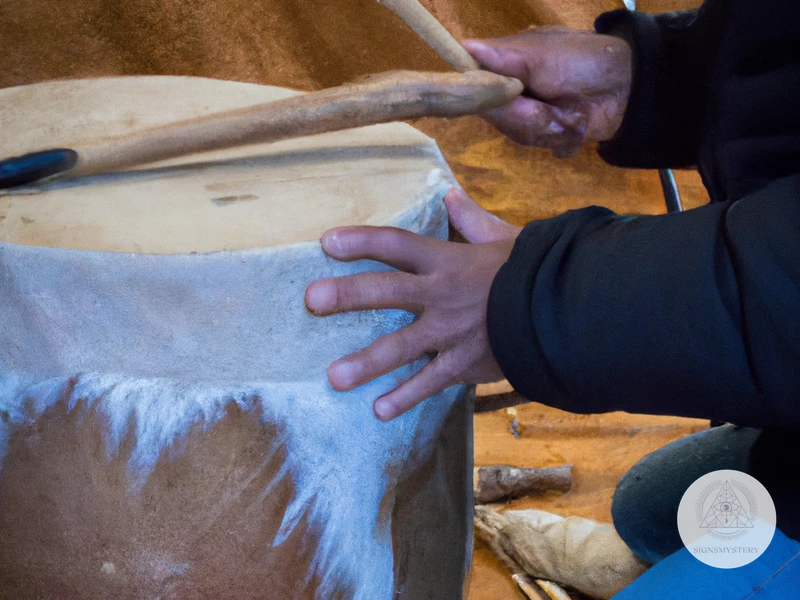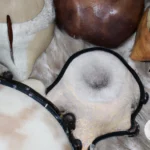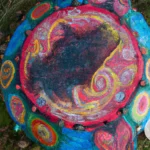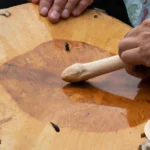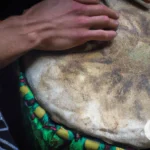Shamanic drum making with real animal hide is a practice that has been passed down through generations and holds significant cultural and spiritual importance. However, the use of animal hide has become a controversial issue in recent times due to ethical and environmental concerns. This poses a question of whether the benefits of using real animal hide outweigh the potential consequences. In this article, we will explore the pros and cons of shamanic drum making with real animal hide, providing a historical and cultural perspective, while also considering the various ethical, legal, and environmental issues at play. By the end of this article, you will be equipped with the knowledge necessary to make an informed decision about your own shamanic drum creation.
What is shamanic drumming?
Shamanic drumming is a practice that involves the use of a drum to enter into a trance-like state of consciousness. This state allows individuals to connect with the spiritual realm and access guidance, wisdom, and healing. This type of drumming has been used for thousands of years by shamans and indigenous communities across the world. The drum is considered to be the shaman’s primary tool, enabling them to communicate with spirits and bring about spiritual transformation. The tempo and rhythm of the drum can also be used to induce states of relaxation and alleviate stress, anxiety, and depression. The importance of shamanic drumming is not limited to healing but also includes divination, guidance, and empowerment. To create such an instrument, real animal hide is traditionally used.
The role of the drum in shamanism
In shamanic practices, the drum plays a crucial role, acting as a “horse” for the shaman to ride into the spiritual realm. The repetitive beating of the drum produces a soothing and calming effect on the shaman, allowing them to enter a trance state. The rhythm of the drumbeat provides a focal point for the shaman to concentrate on, and the sound vibrations allow them to journey to other dimensions and communicate with spirits.
The drum is often considered the heartbeat of Mother Earth and is used to create a sacred space and connect with the natural world. The drum’s circular shape represents the cyclical nature of life, death, and rebirth. It is believed that the spirits of animals reside within the drum, and when played with intention, the energy of the animal’s spirit enhances the shamanic journey.
In some shamanic traditions, the drum is believed to have the power to heal physical and emotional ailments. The rhythmic vibrations of the drum transfer energy into the body, promoting a sense of well-being and balance. The drum also helps to release negative energy and emotions from the body, cleansing the soul and allowing for spiritual growth.
The drum is considered a sacred instrument and should be treated with reverence. It is customary to offer tobacco or other gifts to the spirit of the drum before playing to show respect and gratitude. It is also essential to keep the drum clean and cared for to maintain its energy and integrity.
Using real animal hide for shamanic drum making adds another layer of meaning and significance to the drum. The connection to nature and the animal spirit enhances the drum’s power and helps to establish a deeper connection to the spiritual realm. However, before using real animal hide, it’s important to consider the ethical, environmental, and legal implications.
The importance of authenticity in shamanic practices
In shamanic practices, authenticity is highly valued. It’s not just about creating a drum that looks and sounds good, but it should also feel authentic to the shaman and their cultural traditions. The authenticity of the drum making process can be observed in every step, from selecting the materials to finishing the drum. Using real animal hide, for instance, is a key factor in achieving authenticity. Hides obtained from wild or domesticated animals have a unique texture and quality of sound that cannot be replicated by synthetic materials.
The use of authentic materials in shamanic practices is crucial since it contributes to the spiritual connection that shamans have with their culture and ancestors. Authenticity in shamanic practices involves not only using traditional and authentic materials but also continuing traditions correctly. Substituting fake materials that may appear outwardly similar to authentic ones might not maintain the same level of spiritual energy. As shamanic practices often involve invoking the spirits of ancestors and animal guides, the importance of authenticity cannot be overstated.
Shamanic drumming and the practice of using animal hides go hand in hand. Shamans perceive the drums as their allies that call forth spirits and animal guides to assist in their spiritual journeys. A drum made with synthetic leather, for instance, would not have the same effect as one made with authentic animal hide. The symbolism behind natural hide carries a power that is respected and valued in many shamanic traditions.
The importance of authenticity in shamanic practices cannot be discussed without touching upon ethical considerations. The practice of using animal hides for shamanic purposes has been debated for many years, with some believers arguing that the practice falls under cultural beliefs that promote respect for animals’ spirits. Although modern society now places importance on ethical treatment of animals, shamanic traditions and animal pelt use remain central to some cultures. In this article, we focus on the importance of genuine animal hide in shamanic drum making art and provide links to resources discussing ethical considerations, conservation efforts, and care for fur and pelts used in shamanic practice (see Ethics of Fur Pelts in Shamanic Practice, Fur and Pelt Care for Shamanic Use, and Conservation Role of Shamanism in Endangered Species for more information).
Using real animal hide: A historical and cultural perspective
Using real animal hide for shamanic drum making is a practice that dates back many centuries. In many indigenous cultures, drums were seen as sacred and were often used in various rituals and ceremonies. Drumming was believed to connect the shaman with the spirit world, allowing them to communicate with their ancestors and other spiritual beings. The materials used in the construction of these drums were carefully selected and often held great cultural and spiritual significance.
In many Native American traditions, animal hides were used in shamanic practices as they believed that the hides had a connection to their spirit animal. According to animal fur symbolism in shamanism, animals were believed to have unique characteristics that represented different aspects of human nature. Using animal hides in drums was seen as a way to channel their spirit and energy, providing a deeper connection to the spiritual realm.
There were also practical reasons for using real animal hides. Many animals, such as deer and buffalo, were a source of food and clothing for indigenous people, therefore hides were a readily available material for drum making. Additionally, animal hides were known for their durability and tone quality, making them an ideal material for creating shamanic drums.
In some cultures, fur pelts were also used in shamanic practices. Shamanic robes and headdresses were constructed using animal pelts to symbolize the shaman’s connection with the spirit world. In some cases, specific animals were chosen to represent certain spiritual characteristics. For example, in some Native American traditions, coyote and fox pelts were associated with trickster spirits and were worn by shamans to invoke their energy.
Despite the long history of using real animal hides in shamanic practices, the use of these materials has come under scrutiny in recent times due to ethical and environmental concerns. Some people argue that using animal hides is a form of exploitation and promotes the destruction of wildlife. Others believe that technological advances have provided better alternatives that are more ethical and environmentally friendly.
Regardless of the debate surrounding the use of real animal hides in shamanic practices, it is important to acknowledge and respect the historical and cultural significance of this practice. For those who choose to continue using real animal hides, there are ways to ensure that they are sourced ethically and sustainably. Ultimately, the decision to use real animal hides in shamanic drum making is a personal one that should be made with awareness and respect for both the cultural and environmental implications.
Pros of Using Real Animal Hide for Shamanic Drum Making
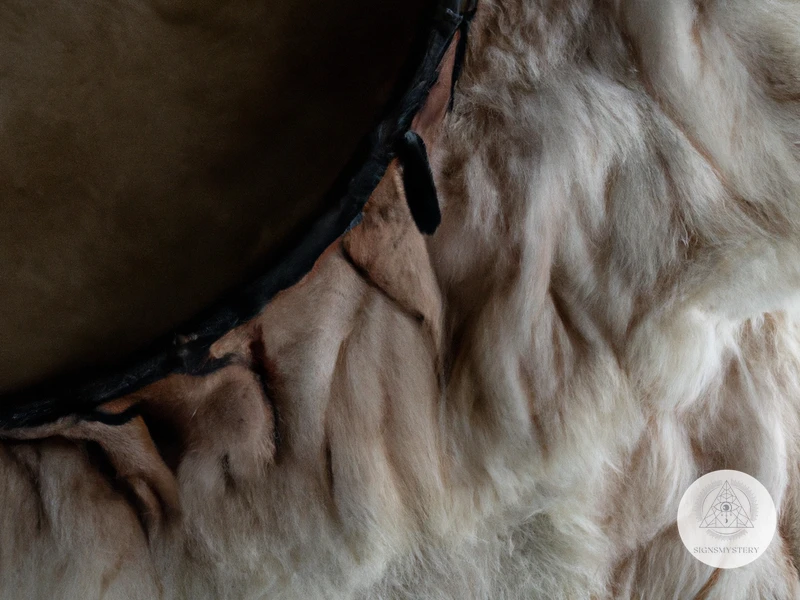
1. Sound quality
One of the main pros of using real animal hide for shamanic drum making is the sound quality that it produces. Real animal hide has unique acoustic properties that synthetic materials simply cannot replicate. The thickness and density of the hide can significantly affect the tone and resonance of the drum. Additionally, because each animal is unique, the sound of each drum made from real animal hide is also unique.
2. Durability
Real animal hide is also more durable than synthetic materials. The hide can withstand wear and tear over time and can even improve with age. The natural oils and fats in the hide help to keep it supple and resistant to cracking, leading to a longer lifespan for the drum.
3. Aesthetics
Another advantage of using real animal hide is the aesthetic appeal it brings to the drum. The natural markings and textures of the hide create a visually striking and unique instrument. The use of real animal hide can also add a deeper cultural and historical significance to the drum.
4. Connection to nature and ancestors
Finally, using real animal hide for shamanic drum making can strengthen the connection between the shaman and nature. Many indigenous cultures believe that by using animal hides in their rituals, they are honoring and connecting to the spirits of the animals and their ancestors. The use of real animal hide can also add a layer of authenticity and spiritual significance to the drumming experience.
While there are certainly drawbacks to using real animal hide for shamanic drum making, the advantages in terms of sound quality, durability, aesthetics, and cultural significance cannot be ignored. It is ultimately up to the individual shaman to weigh these pros and cons and decide what materials best align with their ethical and spiritual beliefs.
1. Sound quality
The sound quality of a shamanic drum made with real animal hide is unparalleled. When a drum is made with synthetic materials, it can sound dull and lack depth. Authentic animal hide, on the other hand, produces a full-bodied resonance that adds to the spiritual experience. The richness of the sound from a real animal hide drum is due to the unique characteristics of each hide. The thickness and texture of the hide, as well as the specific animal it came from, all contribute to the drum’s distinct sound.
In shamanism, the sound of the drum is believed to be more than just an auditory experience. The vibration of the drum creates an energetic frequency that the shaman can use to enter an altered state of consciousness. This state allows the shaman to connect with the spiritual realm and access information from the spirit world. The high-quality sound of an authentic shamanic drum made with real animal hide enhances the ability of the shaman to connect to the spirit world.
Additionally, the sound of the drum can be used for healing. The rhythmic beating of the drum has a calming effect on the mind and can induce a meditative state of relaxation. This state of relaxation is known to promote healing and reduce stress, anxiety, and depression. A shamanic drum made with real animal hide has superior sound quality for facilitating these healing experiences.
The sound quality of a shamanic drum made with real animal hide is one of the main reasons why it is preferred by many practitioners. The sound is richer and deeper than synthetic alternatives, and it allows for a higher level of spiritual connection and healing.
2. Durability
Durability is another major advantage of using real animal hide for shamanic drum making. Unlike synthetic materials, animal hide is built to last, and when properly taken care of, it can withstand years of use. When exposed to moisture or humidity, synthetic materials can weaken and break down over time. However, with animal hide, the natural oils actually help the drum maintain its structure and flexibility, making it an ideal material for those who plan on using their drum for many years to come.
Animal hide can withstand a lot of wear and tear without blemishing or showing signs of damage. When crafting a drum out of animal hide, it’s important to select a hide of the appropriate thickness and quality to ensure maximum durability. A drum made from sturdy hide can be used for a variety of purposes, including meditation, healing sessions, ceremony, and more.
One drawback to consider is that certain types of hides may be more prone to damage than others. For example, softer hides like deer or elk may be more susceptible to punctures and scratches than tougher hides like bison or cow. However, proper care and maintenance can go a long way in ensuring the longevity of your drum.
It’s worth noting that animal hide drums have been used for centuries by various indigenous communities around the world. When it comes to shamanic drumming, animal pelts are believed to offer a powerful connection to the spirit world. The durability of these drums is one of the factors that allows them to be used in rituals and ceremonies over long periods of time.
There is no doubt that animal hide offers an unparalleled level of durability when it comes to shamanic drum making. Whether you’re looking for a drum to use in your personal practice or for professional purposes, real animal hide may be the best material to consider.
3. Aesthetics
When it comes to the aesthetics of shamanic drums, using real animal hide can add a unique and authentic touch to the finished product. Each hide has its own distinct markings and patterns, making each drum one-of-a-kind. The natural variations in color and texture can also contribute to the visual appeal of the drum.
In some shamanic traditions, certain animals are believed to hold special spiritual significance. For example, in Native American traditions, the coyote and fox are revered for their intelligence and cunning. Incorporating shamanic coyote or fox pelts into a drum design can honor these animals and the spiritual qualities they represent.
However, it’s important to note that using real animal hide in drum making can also come with ethical and environmental concerns. It’s a personal decision that each practitioner must make for themselves. For those who do choose to use real animal hide, there are steps they can take to ensure it is sourced ethically and sustainably.
4. Connection to nature and ancestors
Using real animal hide in shamanic drum making has a profound symbolic meaning for many cultures. It connects the practitioner to the natural world and to their ancestors in a way that synthetic materials cannot replicate.
The hide of an animal holds within it the essence of the creature it came from. When used to create a drum, this essence is activated by the vibrations of the drumming, creating a powerful connection between the drummer, the drum, and the spirit of the animal.
In indigenous cultures, animals are viewed as sacred beings that are connected to the earth and to human beings. Using real animal hide to create a shamanic drum is seen as a way of honoring and respecting the animal’s spirit and acknowledging the interconnectedness of all living things.
Using synthetic materials for drum making may be more convenient, but it does not offer the same depth of connection to nature and culture that real animal hides can provide. It is important to consider the cultural significance of these practices and the importance of honoring tradition and heritage.
To deepen the connection to nature and ancestors, some people choose to use hides from animals that lived in their local area, making the drum an even more personal and meaningful object. This choice can enhance the spiritual experience and connection to the land.
The use of real animal hide in shamanic drum making offers a powerful way to connect with nature, honor ancestral traditions, and deepen the spiritual experience. Combining authentic materials and traditional techniques can create a truly unique and meaningful instrument for spiritual practice.
| Benefits of Connection to Nature and Ancestors in Shamanic Drum Making | Examples |
|---|---|
| Access to deeper spiritual experiences | Feeling a stronger connection to the natural world and its rhythms during drumming. |
| Increased cultural reverence and respect | Practicing traditional ways of making a shamanic drum infuses the drummer with a sense of culture and history. |
| Personal connection to the drum | By using hides from local animals, drummers can deepen their connection to their home and surrounding environment. |
Cons of Using Real Animal Hide for Shamanic Drum Making
While there are certainly pros to using real animal hide for shamanic drum making, it is important to consider the cons as well. Here are some factors to keep in mind:
One of the most obvious cons of using real animal hide for drum making is the ethical considerations. Many people are uncomfortable with the idea of using animal products, and may feel that it is wrong to take the hide of an animal to create something that is not necessary for survival. Additionally, some animals may be killed solely for their hides, which could be seen as wasteful or unnecessary.
Another con of using real animal hide is the environmental impact. The process of tanning animal hides requires a considerable amount of chemicals and water, which can be harmful to the environment if not disposed of properly. Additionally, some types of animal hides may be sourced from endangered or threatened species, which could have a negative impact on the ecosystem.
It is important to note that there may be legal restrictions on the use of certain types of animal hides. For example, the importation of certain exotic animal hides may be illegal in some countries. It is important to research and comply with local laws and regulations related to the use of animal hides in drum making.
Finally, some people may argue that there are technological substitutes available that can replicate the sound and feel of real animal hide without relying on the use of animal products. Synthetic materials such as Mylar and Kevlar can be used to create drum heads that are durable and high-quality, without the ethical and environmental concerns associated with real animal hides.
While using real animal hide for shamanic drum making can certainly have its benefits, it is important to carefully consider the potential cons as well. Ethical considerations, environmental impact, legal restrictions, and technological substitutes are all important factors to take
Subscribe to Our Newsletter
Sign up to receive the latest news and updates.
1. Ethical considerations
Using real animal hide for shamanic drum making raises significant ethical considerations that cannot be ignored. Many people argue that it is unethical to use animal hides for any purpose, let alone for drum making, as it perpetuates the commodification and exploitation of animals for human benefit.
Animal rights activists and organizations voice their concerns about the inhumane treatment of animals by the commercial fur and leather industries. These industries have been known to engage in cruel practices such as trapping, electrocution, and skinning animals alive. While the shamanic community may claim that their use of animal hides is different from commercial activities, it still raises the question of whether it is ethical to use any animal product for one’s personal spiritual practices.
Many animal species are facing extinction due to loss of habitat, poaching, and other human activities. The use of animal hides for drum making may contribute to the depletion of endangered species and disrupts the delicate balance of ecosystems.
Another ethical consideration is cultural appropriation. The appropriation of Indigenous culture and practices by non-Indigenous peoples has been a longstanding issue in North America. The use of animal hides for shamanic drum making by non-Indigenous people perpetuates this issue, as it leads to the commodification and dilution of Indigenous cultural practices and traditions.
While some may argue that using animal hides for shamanic drum making is a way of honoring and connecting with nature and the ancestors, it is essential to consider the ethical implications of these practices and to question the impact they may have on the environment, animal welfare, and Indigenous culture. Ultimately, the choice of whether to use real animal hides for shamanic drum making lies with the individual practitioner, but it is imperative to make an informed and conscious decision.
2. Environmental impact
When it comes to using real animal hide for shamanic drum making, one of the major concerns is its environmental impact. The process of obtaining animal hide involves the use of harmful chemicals and requires a significant amount of resources, which can result in negative consequences for the environment.
Habitat loss: The demand for animal hide can lead to habitat loss and destruction as it encourages the hunting and breeding of animals, which can threaten the local ecosystem. Some animals may be killed merely for their skin, which can lead to a decline in their population and the extinction of some species. The destruction of habitats also affects the plant species, which may adversely affect the local environment.
Pollution: The process of tanning animal hide can have a significant impact on the environment. In many cases, it involves the use of harmful chemicals such as formaldehyde, chromium salts, and ammonia, which can contaminate the soil and water. These chemicals not only pollute the environment but can also be hazardous to human health. The discharge of pollutants into water sources can harm aquatic life and negatively impact food chains.
Carbon footprint: The production of animal hide requires a significant amount of resources and energy, contributing to its carbon footprint. The transportation of raw skins, the production of chemicals, and the energy consumption involved in tanning and processing all contribute to the carbon footprint of animal hide production. It is worth noting that the carbon footprint is higher for animal hides that are imported from other countries.
While there are efforts to reduce the environmental impact of animal hide production, it is still essential to consider the impact of using real animal hide for shamanic drum making. It is crucial to weigh the pros and cons and make an informed decision on using real animal hide or alternative materials for drum making.
3. Legal restrictions
It is important to note that in certain areas, using real animal hide for shamanic drum making may be subject to legal restrictions. Some countries and regions have strict laws regarding the use of animal products, particularly if it involves endangered species or protected animals.
For instance, the Convention on International Trade in Endangered Species of Wild Fauna and Flora (CITES) has placed restrictions on the trade and sale of animal hides and other products from endangered species. This means that if you are using hides from certain animals, you may need to obtain permits or prove that the animals were not taken illegally.
In addition to CITES restrictions, local laws and regulations may also apply, and it is essential to research and follow these laws to avoid fines or penalties. For example, some US states prohibit the use of certain animal products, including bear hides, and require permits or licenses for other types of hides.
It is worth considering that even if using animal hides is legally permitted in your area, it may not be ethically or morally acceptable to everyone. Some people may view the use of animal hides for drum making as cruel or unnecessary, particularly if the animals were not raised and slaughtered for food.
Ultimately, it is up to the individual to determine whether using real animal hide for shamanic drum making aligns with their personal values and beliefs. There are alternatives available, such as synthetic materials that can replicate the sound and feel of real animal hide, and exploring these options may be a more ethical choice for some individuals.
4. Technological substitutes
Technology has provided us with an alternative to using real animal hide for shamanic drum making. While some traditionalists might argue that this is not authentic or in line with shamanic practices, it is nonetheless an option worth considering. Here are some substitutes to using real animal hide for shamanic drum making:
1. Synthetic drum heads: These are made from materials such as mylar, which is a type of polyester film. They are a popular choice for drummers as they are durable, have consistent sound quality, and are affordable. However, they lack the spiritual and cultural significance of real animal hides.
2. Alternative natural hides: If using real animal hides is not an option for ethical or legal reasons, there are other natural hides that can be used such as fish skin, snake skin, or even cowhide. These substitutes offer a diverse range of textures and sounds, but may not provide the same level of cultural and spiritual connection as traditional hides.
3. Electronic drums: Electronic drum kits have become increasingly popular due to their versatility and sound quality. They can mimic the sound of traditional shamanic drums, and even have the added benefit of incorporating modern technology such as MIDI controllers and drum pads. However, there is no cultural or spiritual connection to these substitutes.
4. 3D printed drums: With advancements in technology, it is now possible to 3D print drum shells and synthetic drum heads. This allows for unique and customizable designs, but lacks the authenticity and natural feel of traditional shamanic drums.
It is important to note that while these substitutes offer alternatives to using real animal hide, they may not fully replicate the cultural, spiritual, and traditional value of traditional shamanic drum making. The decision to use technology or alternative materials ultimately comes down to personal preference and belief.
Conclusion
After considering the pros and cons of using real animal hide for shamanic drum making, it ultimately comes down to personal values and beliefs. While real animal hide offers superior sound quality, durability, aesthetics, and a connection to nature and ancestors, it also raises ethical, environmental, and legal concerns.
There are substitute materials available, such as synthetic drum heads, which can alleviate some of these concerns. However, they may not provide the same depth of connection to the natural world and ancestral traditions that real animal hide can offer.
Ultimately, the choice is yours. It is important to weigh the pros and cons and make an informed decision based on your personal values and beliefs. It is also essential to acknowledge and respect the cultural significance of shamanic drumming and the importance of authenticity in shamanic practices.
In conclusion, shamanic drum making with real animal hide is a complex issue with no easy answers. As with any spiritual practice, it is crucial to approach it with respect and humility, and to continually grow and learn as a practitioner.
The choice is yours
After weighing the pros and cons, the decision whether or not to use real animal hide for shamanic drum making ultimately comes down to personal beliefs and values. It is important to reflect on your intentions and the impact your choices will have on the environment, animals, and cultural communities.
For those who believe in the importance of authenticity and connecting with nature and ancestry, using real animal hide may be the preferred choice. The unique sound quality, durability, and aesthetics of real hide can enhance the experience of shamanic drumming and deepen one’s connection to the spiritual world.
However, ethical considerations cannot be ignored. It is crucial to ensure that the animal hide being used is ethically sourced, meaning that the animal was not killed solely for the purpose of drum making and that the process of acquiring the hide did not involve cruelty or exploitation. Additionally, environmental impact and legal restrictions must be taken into account.
Alternatively, there are technological substitutes available that can mimic the sound and appearance of real animal hide, such as synthetic materials or drum heads made from recycled materials. These options may alleviate ethical and environmental concerns while still allowing for a meaningful shamanic drumming experience.
Final thoughts on shamanic drum making with real animal hide
Shamanic drum making is a sacred and spiritual practice that should be approached with reverence and respect. While using real animal hide has its advantages, it is important to carefully consider the impact of our choices on the natural world and the communities involved. Ultimately, the decision whether or not to use real animal hide is a personal one that should align with our own values and beliefs.
Final thoughts on shamanic drum making with real animal hide
Shamanic drum making with real animal hide is a deeply personal and meaningful experience for many people. It connects them to nature, to their ancestors and to their spirituality. However, it is important to carefully consider the pros and cons before deciding to use this material.
On the one hand, real animal hide offers superior sound quality, durability and aesthetics that cannot be replicated with synthetic materials. It also serves as a powerful symbol of connection to the natural world and to the history and traditions of shamanism.
On the other hand, there are ethical, environmental and legal considerations that cannot be ignored. Some people may feel uncomfortable using animal hide for their drum and prefer to opt for synthetic materials. The environmental impact of using animal hide needs to be considered as well, especially in terms of the potential over-harvesting of animal populations.
Ultimately, the decision to use real animal hide for shamanic drum making is a personal one that needs to be made after weighing all the factors involved. However, it is important to remember that there are alternatives available that still offer a quality drumming experience without the potential harm associated with using real animal hide.
To summarize, here are some key takeaways from this discussion on shamanic drum making with real animal hide:
- Real animal hide offers superior sound quality, durability and aesthetics that cannot be replicated with synthetic materials.
- Using real animal hide allows for a deeper connection to nature, to ancestors and to spiritual practices.
- However, there are ethical, environmental and legal considerations that cannot be ignored when using real animal hide for shamanic drum making.
- Alternatives to using animal hide exist that still offer a quality drumming experience without potential harm to animal populations.
- The decision to use real animal hide is a personal one that needs to be made after weighing all the factors involved.
Shamanic drum making with real animal hide is a powerful and committed process. It offers both advantages and disadvantages, and each person should make their choice based on their values and beliefs. Regardless of the materials used, shamanic drumming remains a meaningful and transformative experience for many people.
Frequently Asked Questions
What kind of animal hide is best for shamanic drum making?
Traditionally, elk or moose hide is preferred for shamanic drum making because of its strong sound quality. However, some shamanic practitioners may choose other animal hides depending on cultural and spiritual practices.
Is it necessary to use real animal hide for shamanic drum making?
No, it is not necessary. There are alternative materials such as synthetic or plant-based materials that can be used for drum heads. However, some shamanic practitioners may prefer the natural authenticity of real animal hide.
Are there any ethical concerns with using real animal hide?
Yes, there can be ethical concerns if the animal was killed inhumanely or without proper respect. It is important to source the animal hide from ethical and sustainable practices, or to use alternative materials if concerned.
What is the cultural significance of using real animal hide in shamanic practices?
For many indigenous cultures, using real animal hide in shamanic practices represents a connection to the natural world and ancestral traditions. It is considered a sacred material and treated with respect in many cultures.
What are the benefits of using real animal hide for sound quality?
Real animal hide has unique sound qualities that cannot be replicated with synthetic or plant-based materials. It produces a deep and resonant sound that is ideal for shamanic drumming.
How can I ensure that the animal hide I am using was ethically sourced?
One way to ensure ethical sourcing is to purchase animal hide from reputable suppliers who have transparent sourcing and processing methods. Another option is to learn how to process the hide yourself or to source directly from hunters or farmers who prioritize ethical practices.
What are the potential environmental impacts of using real animal hide?
One concern is over-harvesting or unsustainable sourcing practices of animal hide. It is important to choose suppliers who prioritize sustainable and ethical practices, or to consider alternative materials that have less environmental impact.
Are there any legal restrictions on using real animal hide for shamanic drum making?
There may be restrictions on using certain types of animal hide for shamanic drum making depending on the laws and regulations of your country or region. It is important to research and adhere to these regulations to avoid legal issues.
What are some alternatives to real animal hide for shamanic drum making?
Synthetic materials such as mylar or plant-based materials such as rawhide can be used as drum heads. However, they may not produce the same sound quality or authenticity as real animal hide.
What is the significance of the drum in shamanism?
The drum is considered a powerful tool for shamanic practice as it represents the heartbeat of Mother Earth and connects the shaman to the rhythm of the natural world. It is also used as a tool for journeying and communication with spirits.

